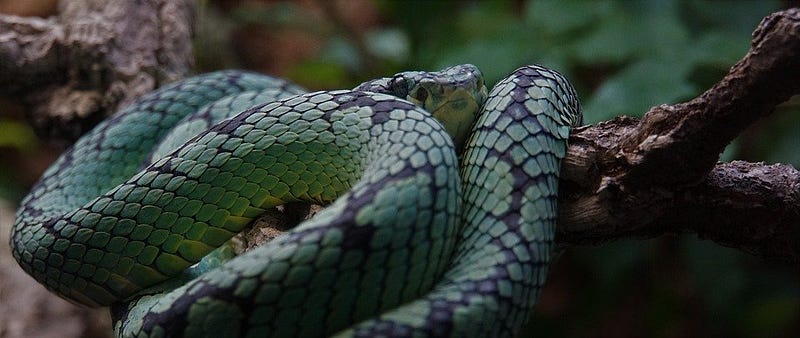Ophidiophobia: why you may have it
By Lucas Principe, Philosophy and Environmental Science, 2020

This article was originally published in Issue 40: Wonder.
Ophidiophobia, or the fear of snakes, is consistently listed as one of America’s top aversions, along with public speaking, heights, needles, and small spaces. Most notably, a 2001 Gallup poll found over 50 percent of Americans fear these serpentine reptiles — even though most Americans probably don’t interact with them on anywhere near a regular basis.
I actually own a pet snake. A three-foot-long Ball Python. He’s a lovely pet. And he loves to wrap himself around my neck and crawl through my shirt. I’ve never been afraid of him. But whenever I take him out of his cage around other people, I watch them recoil. If it’s a boring day at home, I still chase my mother around the house with him while she shrieks. It’s these kind of reactions that made me wonder, why are so many people afraid of snakes?
Surprisingly, there has been a large amount of early developmental research conducted on this phenomenon. The two competing schools of thought are as follows: humans have an innate fear of snakes; or, humans have an evolved predisposition to associate fear with snakes, though the actual fear is not innate. Both of these theories build off the fact that snakes posed a serious threat to our ancient human ancestors. An encounter with one 50 million years ago, before modern medicinal measures such as antivenom, could easily leave a primate dead.
The two competing schools of thought are as follows: humans have an innate fear of snakes; or, humans have an evolved predisposition to associate fear with snakes, though the actual fear is not innate.
One 2017 study by researchers at the Max Planck Institute for Human Cognitive and Brain Sciences, published in Frontiers in Psychology, recorded the pupil dilation reaction in six-month-old infants when shown photos of evolutionarily threatening and non-threatening species. The researchers chose to study this response due to the pupils’ connection to the same neural system — the noradrenergic system — that produces stress in an individual.
The team found infants reacted with larger pupil dilation when shown photos of spiders and snakes as opposed to photos of flowers and fish — suggesting a fear of these animals may be innate in humans.
“It’s a very long period of coevolution — nearly 40 to 60 million years of it, that early human ancestors and spiders and snakes have interacted,” lead researcher Stephanie Hoehl explained to National Geographic. The study concluded that an innate fear of snakes could be an evolutionary defense mechanism against a potentially lethal bite.
The researchers chose to study this response due to the pupils’ connection to the same neural system — the noradrenergic system — that produces stress in an individual.
Other research, however, remains more skeptical about this claim. A 2008 study published in Developmental Science used an auditory-visual matching paradigm with infants aged 8–16 months. The infants were simultaneously presented two films — one of a snake and the other of an exotic animal — appearing with the recording of either a happy or a frightened human voice.
The researchers hypothesized, “if infants have a predisposition to associate snakes with fear…they should look longer at snakes when they hear a frightened voice.” And the team’s data revealed just that — there was a significant tendency in infants to associate snakes with fearful stimuli.
“What we’re suggesting is that we have these biases to detect things like snakes and spiders really quickly, and to associate them with things that are yucky or bad, like a fearful voice,” said Vanessa LoBue, co-author of the study, to Science Daily.
The research suggests that humans can both detect and learn to be afraid of snakes more quickly than other animals. However, the data does not support the hypothesis that the fear of snakes is necessarily innate.
Between 2007 and 2012, the number of American households that own a pet snake increased by 42 percent, according to the American Veterinary Medical Association.
Regardless of the answer, a growing segment of the population is turning away from traditional pets, such cats and dogs, and embracing scaled species instead. Between 2007 and 2012, the number of American households that own a pet snake increased by 42 percent, according to the American Veterinary Medical Association. In the United Kingdom, the British Federation of Herpetologists estimates that, as of 2008, there are 1.5 million more reptiles than dogs being kept as pets.
With numbers like these, it’s increasingly likely that at some point in your life you’ll find yourself walking into the living room of a new friend to find a 10-gallon tank equipped with a heat lamp and a python sitting underneath it. When that happens, overcome your evolutionary tendencies, be calm, and ask to hold it. I promise you’ll be surprised how friendly they can be.
Frontiers in Psychology (2017), DOI: 10.3389/fpsyg.2017.01710
Current Directions in Psychological Science (2010), DOI: 10.1177/0963721410388801